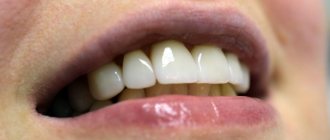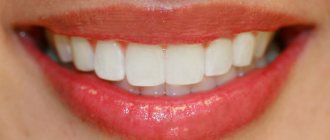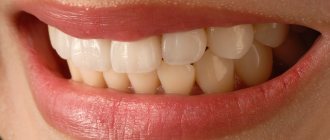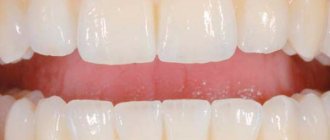From this article you will learn:
- what are veneers in dentistry,
- before and after photos, patient reviews,
- veneers – price for 1 tooth in Moscow (for 2022).
Veneers are microprostheses made of ceramic or composite filling material (in the form of thin plates) that cover the front surface of the teeth. The thickness of standard ceramic veneers starts from 0.6 mm, respectively, and the front surface of the tooth must be ground to the same depth (Fig. 1-3). However, in dentistry there are also so-called “thin veneers” - they are made from Emax glass ceramics. They have a thickness of 0.3-0.4 mm, which in some cases makes it possible to do without tooth preparation.
To complete the picture, it should be noted that there are also so-called ultra-thin veneers for the front teeth, which are produced by DenMat under the brand Lumineers® (Lumineers). The advertisement states that their thickness is only 0.2 mm, which is guaranteed to allow you to avoid grinding off the surface layer of tooth enamel. But this is not entirely true, and the original manufacturer's instructions already clearly indicate that the thickness of the lumineers will be from 0.3 to 0.7 mm (i.e. they will not be thinner than Emax).
What are dental veneers: photo
Correcting teeth with veneers allows you to improve their color and shape, allows you to change the inclination and position in the dentition, and also makes it possible to eliminate wide interdental spaces. Veneers are either “direct” (composite) or “indirect” (orthopedic). Composite veneers are made by dentists from ordinary composite filling material. They cost much less, and their aesthetics and service life are noticeably more modest - compared to higher quality indirect ceramic veneers.
In turn, orthopedic indirect veneers are made in a dental laboratory - mainly from various types of ceramics. The most common types of ceramics used to make veneers are porcelain, lithium disilicate, or zirconium dioxide. It is for such ceramic veneers that patient reviews will be as positive as possible, because... they really allow you to achieve excellent dental aesthetics (which can be seen in Hollywood stars). How much does it cost to install ceramic veneers? Read below.
Important: but patients are faced not only with the problem of choosing between ceramic and composite veneers (here it all comes down to budget). It becomes more difficult when the patient learns that ceramic veneers can be made not only from different types of ceramics, but there are also different technologies for their manufacture - the layer-by-layer ceramic application method, injection molding technique or CAD/CAM technology. And this also affects aesthetics and their service life.
Porcelain veneers
Porcelain plates are visually indistinguishable from the enamel of a normal tooth. Therefore, ordinary people will never guess about the installed records.
The advantages of ceramic crowns are that they are resistant to stress and practically do not stain.
Porcelain microprostheses are made using two methods:
1. Pressed ceramics - the material is applied in layers, then each layer is fired. In this case, the teeth are not ground down.
2. Pressed material – ceramic material is pressed under pressure and then fired at high temperatures. This method is used to achieve the strongest possible structure.
How to make porcelain veneers is decided by the doctor, based on the individual characteristics of the patient.
Plus, the service life of ceramic restorations is more than 20 years. If you decide to put veneers or crowns on your teeth, follow hygiene procedures.
where to go
| Clinic | Address | Price |
| Belgravia Dental Studio | Addresses of branches on the website. T + | From 67,000 rub. |
| Frau Clinic | St. Gilyarovskogo 55 (499) 322-05-18 | From 45,000 rub. |
| MCDI ROOT | Volgogradsky Prospekt 4A +7(800)200-79-50 | From RUR 37,000 |
| Seline | B. Kondratyevsky Lane 7 (499) 444-31-98 | From 38,000 rub. |
| Family dentistry | St. Marshala Rybalko, 2, building 3. (499) 322-22-71 | From 40,000 rub. |
Before making your final choice of clinic, find out more about the doctors. Consider the work “before” and “after”. Make sure consumables are certified. A smile is important.
E-max ceramic veneers and zirconium dioxide
Metal-free veneers contain a frame made of lithium disilicate or zirconium dioxide. Such plates are almost transparent and have a fine structure. And unlike others, their service life increases to 25–30 years.
Pros of ceramic zirconium veneers
• Duration of operation is longer than that of porcelain;
• Lithium disilicate plates look natural, regardless of lighting;
• Color does not change after eating food coloring;
• Do not accumulate plaque if the rules of oral hygiene are ignored;
• Does not have a black coating when smoking;
• They are light in weight and thin, so wear off of the enamel is minimal.
Zirconium veneers, unlike composite plates, are placed on teeth, even in the most difficult clinical cases. Usually, they are inserted in the smile zone - on the 10 upper and 8 lower teeth.
The downside is that the insertion process takes longer due to the fact that the material is difficult to fix on the tooth surface.
Installation requires minor tooth grinding.
Replacement steps
After removing the veneers, the surface of the teeth is cleaned of cement residues. If necessary, dental treatment is performed before veneers are replaced. In most cases, additional preparation (enamel removal) is not required. The process of replacing veneers with new ones follows the same algorithm as the initial installation:
- taking an impression;
- color selection;
- installation of temporary overlays;
- production of veneers;
- fixation.
Composite veneers (componeers)
They are made from filling material in two ways and differ in how veneers are placed on the teeth:
1. Aesthetic filling (therapeutic) - installation occurs in one stage. Specialist. Using equipment, the doctor polishes the front side of the tooth. Then filling material is applied to this plane. Apply as thin a layer as possible. This method can hide only minor aesthetic problems.
2. Production of composite plates in a dental laboratory using special impressions. Before installing veneers on the front teeth, the dentist grinds down the enamel. The process requires several steps, so the implants are fixed at subsequent appointments.
The downside is that the service life of composite veneers is 5 years. A significant disadvantage is also a change in the color of the plates - darkening of the cladding.
What materials are veneers made from?
Only veneers made from a ceramic composition can be considered original.
Sometimes in dentistry, visitors are offered the fixation of veneers made of other materials - on an aluminum or zirconium base. As a budget alternative to such veneers, veneers created from composite can be compared. The production of such veneers in the Russian Federation differs significantly from the technologies usual in Europe. True composite veneers must be produced within the framework of a professional dental laboratory operating in dentistry. Veneers are given a shape identical to the parameters of the patient’s teeth. This is achieved through the preliminary creation of impressions. Impressions for veneers are taken by orthopedic dentists during the process of preparing teeth for attaching veneers.
In Moscow, most clinics do not have their own laboratories, so composite veneers are created in violation of real technology. Such veneers turn into analogues of ordinary filling masses. Veneers are fixed on the surface of the front teeth during treatment procedures using standard restorative compounds with light-curing fillings. This turns the veneer into a typical falsification.
Ceramic veneers
Veneers made from high-quality ceramics have long been awarded the title of Hollywood. Such veneers are often considered analogues of indirect veneers and orthopedic veneers. Such names are dictated by the manufacturing features. The creation of such veneers is not done in dentistry during the session, but in a special laboratory before the start of therapy.
In all the variety of ceramic veneers, two large varieties can be distinguished. In addition to porcelain veneers, Moscow dentists suggest considering the installation of veneers made of zirconium alloys.
Porcelain veneers
Porcelain is rightfully considered the base material for creating veneers. It is most similar to the appearance of human tooth enamel and its structure. The increased strength of the material and the preservation of color throughout the entire service life of the veneers cannot be ignored. Additional translucency improves the aesthetic qualities of veneers.
restoration of front teeth with veneers before and after photos
Quite often, patients are not satisfied with the condition of the restoration of their front teeth. To correct the situation, dental specialists suggest completely eliminating the unsuccessful restoration and fixing veneers made of first-class porcelain to the teeth.
There are two methods that can be used to make porcelain veneers:
The first technique helps achieve maximum aesthetics, and the second is aimed at obtaining maximum strength indicators of the incisors. The method according to which the specialist will act is determined by the dentistry you contacted. The average production time for veneers ranges from one to two weeks. At this time, your ground teeth will be covered with special temporary veneers made of high-quality plastic.
Veneers. Method of layer-by-layer application of porcelain mass and firing it
One of the most common situations considered by employees of any dentistry is the creation of veneers for the fourth and fifth teeth. Dentists prefer to apply a special porcelain mixture to the client’s prepared teeth. It is distributed over the teeth gradually and in layers. During the work process, a dental specialist can vary the thickness, color and level of transparency of the layer to create the highest quality veneers on the visitor’s teeth. This technique allows you to achieve a perfect match of the color of nearby teeth. This is what gives the look a natural look.
Veneers. Injection molding method under pressure and high temperature
Now we are talking about “pressed ceramics”. Veneers produced using this method become less fragile, which contributes to long-lasting wear and increased reliability.
Porcelain veneers for front teeth: before and after photos
Zirconium dioxide ceramic veneers
Zirconium veneers have two layers. The lower one is made up of a high-strength zirconium frame, and the outer surface of the veneer is represented by a porcelain mass. The frame is created using a unique technology of three-dimensional milling of veneers. Dentistry using this technology must have CNC machines. They do not require human intervention, therefore they guarantee products of impeccable quality and accuracy.
The procedure consists of several successive steps. First, in dentistry, a specialist grinds the patient’s teeth for installation of veneers, after which he makes a reliable impression of each incisor being processed. Based on the impression taken, a virtual three-dimensional model of the future veneer will be built using special dental equipment. The operator transfers the data of the simulated veneer to the machine for turning the workpiece.
Zirconium veneers are stronger and harder than pressed porcelain veneers. An excellent result can be achieved in any dentistry in Moscow if its employees strictly follow the technology of firing the resulting blanks for veneers. Unfortunately, it is not uncommon for clinics to violate accepted technology. The technique is completely new, and not every dentist has managed to master it at the proper level. Deviation from the original technology is fraught with the formation of chips on the ceramics after installing veneers on a patient.
Making veneers photo process
Ceramic veneers: reviews, advantages
In addition to excellent aesthetics, installing ceramic veneers in dentistry can achieve:
- — complete color stability throughout the entire service life of the veneers;
- - incredible reliability (the service life of veneers is limited only by a person receiving dental injuries in extreme situations).
The only drawback of ceramic veneers is their rather high price.
Differences between porcelain veneers and zirconium dioxide veneers: By installing porcelain veneers, dental professionals are able to achieve incredible translucency of the material. Zirconium products have more modest translucency indicators because they have increased density.
For patients with a high level of transparency in their own teeth, it is advisable to choose veneers made from a porcelain mixture. For some clients, the tooth enamel has a more saturated color. Then veneers of these two varieties will be quite appropriate. Porcelain veneers can be given the desired degree of translucency by varying the number of layers.
Sign up for a consultation at our clinic
Indications for installation of veneers
1. People who were unable to achieve the desired teeth color.
2. Darkening of the tooth enamel occurred due to a filling made with formaldehyde paste, or when a nerve was removed.
3. Old fillings that have changed their color and differ from tooth enamel.
4. They are given to people who have diastemas, trema, and chips.
5. When the teeth have an irregular anatomical shape (wedge-shaped).
6. The patient has diseases - this could be enamel erosion, necrosis, hypoplasia, etc.
But is it still possible in some cases?
All cases are individual, so the final decision can only be made at an appointment with a doctor. It is indeed possible to hide slight crooked teeth with the help of veneers - if it is not associated with an incorrect bite. We are talking literally about 1–2 millimeters. By choosing the shape of the plates, you can level out tooth rotation. If one tooth is slightly pushed back relative to the others, a veneer that is slightly thicker than the others can be installed on it. Also, with the help of veneers it is easy to hide a small diastema.
A slight curvature can be hidden, a very pronounced one cannot.
It must be said that mildly expressed defects in the position of teeth can easily be corrected with the help of aligners in just a few months. You will not have to install braces, and the treatment will be completely invisible to others. If you like the shape and color of your teeth and the enamel has no flaws (fluorosis, stains, darkening), then orthodontic treatment will give an equally attractive result. In addition, there will be no need to grind down healthy teeth.
In any case, if the teeth are positioned incorrectly, it is best not to hide it, but to have it treated by an orthodontist, eliminating the underlying problem. And then move on to aesthetic procedures. If you carry out treatment in this order, the result will be the best possible.
Who are veneers contraindicated for?
People who have the following diseases and problems are not recommended to get implants.
• The presence of a dental anomaly “bruxism” is a forceful clenching of the jaws during sleep.
• Insufficient amount of tooth enamel.
• Bite pathology, meaning straight, deep bite.
• Caries and its complications.
• A group of diseases that are characterized by inflammatory processes - gingivitis, periodontal disease, etc. These diseases are a temporary contraindication. After treatment, the structures are successfully installed.
• Severe tooth fragility, or the presence of a bulky filling.
Care
Onlays do not require special care, but some requirements must still be observed to ensure the durability of these dental structures:
- hygienic oral care procedures must be carried out twice a day so that the plates do not lose their appearance;
- You should avoid sudden changes in temperature in the oral cavity during meals;
- it is advisable to avoid putting pressure on the teeth on which the plates are installed - biting off very hard food, crunching nuts, candy, etc.;
- try not to abuse drinks that can stain installed structures - strong tea, coffee, rich red juices;
- Visit your dentist twice a year to check the condition of the veneers and their possible correction;
- If the onlay falls off the tooth, save it, the doctor will put it in place.
Gone are the days when a person could be embarrassed about his smile due to defects in his teeth. Now almost any situation can be corrected in an unnoticeable way. Veneers are one of them.
In conclusion, you will find an interesting video from which you will learn a lot of interesting information about this type of fixed dentures:
If you find an error, please select a piece of text and press Ctrl+Enter.
Tags veneers dentures fixed dentures photos
Did you like the article? stay tuned
Veneers and Lumineers, and how they differ
Lumineers are crowns made from special dental porcelain.
Lumineers are produced by the American company, which has developed and patented the specific composition of dental porcelain and production technology. This company produces lumineers in California. Therefore, the production of such micro prostheses takes about 30 days.
The word lumineers comes from the Latin word “lumen”, which literally means “light”. The creators of lumineers claim that your teeth will become much whiter. This means that the client will receive a “Hollywood smile”. However, veneers are not much inferior to lumineers. The latter can be distinguished rather by their “luminous effect”, but otherwise they are simply an analogue of ceramic veneers.
A significant advantage of lumineers is the thickness of the plate. It is: 0.2 - 0.3 mm, and the thickness of the veneers: from 0.2 mm. up to 0.8 mm., therefore, lumineers are installed without preliminary turning, just like veneers. The impression is made directly from the tooth.
Teeth after lumineers
Lumineers can serve you for quite a long time (up to 15 years), and to remove them you need certain indications. For example, functional, when the veneer came off, broke or cracked, or aesthetic, if you wanted to improve your smile.
In these cases, it will be necessary to remove the non-prep porcelain veneers and do all the installation work again. When removing lumineers, the enamel layer is also worn down a little more. In rare cases, a new veneer can be glued on top of the old layer, thereby causing less trauma to the tooth.
Preparatory process
1. Hygienic teeth cleaning, plaque removal.
2. Grind down a thin layer of enamel, from 0.5 to 0.7 mm.
3. A harmonious shade is selected.
4. The remaining enamel is coated with a special acid.
5. An impression is made.
6. The tooth plate is carefully polished and onlays are inserted.
A thin layer of enamel is ground off in order to achieve the most harmonious and natural look. They also grind it in order to insert and firmly strengthen the plate.
Microprostheses on fangs
For many people, their self-confidence depends on how good their smile looks. Often, by nature, fangs are curved or protrude to the side. This creates inconvenience and provokes the development of complexes. In such situations, it is possible to install aesthetic overlays on the fangs.
The photos below show how much the situation can be improved.
The process of installing permanent veneers
Permanent microprostheses are placed at the second appointment. First, the orthopedist visually assesses how suitable the finished model is:
- According to the form;
— By color;
- According to the tightness of fit to the surface of the tooth.
When the dentist is convinced that the characteristics are correct, the onlays are installed.
1. The finished structure is fitted.
2. Then they control the accuracy and tightness of the fit.
3. The procedure is completed with fixation of microprostheses.
Questions and answers
Is it possible to hide or disguise a crooked tooth with a veneer?
Good afternoon Tell me, is it possible to hide/disguise it with a veneer if a tooth is crooked? On my right, the fang goes inside the jaw. I don’t want to get braces, and I can’t afford the money for mouthguards. It seems like the solution is veneers, but I need your preliminary advice.
Hello!
Theoretically, such defects can be corrected by installing veneers. However, only a doctor can answer you for sure based on the results of the examination. Come to our specialists for a free consultation, the doctor will explain to you all the details of veneer prosthetics and write out a treatment plan indicating the cost. Our clinic uses highly aesthetic Empress veneers made from ultra-strong ceramics. For more details and to sign up for a free consultation, please call +. Sincerely, Patient Support Center SIMPLADENT++8 800 333-53-41 Other questions
Is it possible to get veneers without grinding teeth?
In order to avoid grinding down the enamel, veneers made from feldspar and E-max should be inserted; they are thinner and do not require such a procedure.
It is possible to refuse turning if:
1. You have uneven teeth;
2. If the teeth are heavily worn;
3. It is necessary to change the direction of a crooked tooth;
4. It is necessary to add volume to the tooth.
There are no ideal teeth, so veneers without grinding cannot yet be placed. Except if the teeth are sparse and not voluminous. Grinded teeth can no longer be restored in the future, so you will always need to install crowns or their equivalents.
Is it possible to shoot and in what cases?
Veneers can be removed if necessary. Teeth onlays are installed for patients who have aesthetic defects in the enamel - darkening, chips, cracks, fillings in visible areas. Using artificial material, you can disguise defects and get a perfect smile.
On a note!
Veneers mean snow-white, straight, shiny and attractive teeth. It is rare that a patient wants to permanently remove correction plates from their teeth. Most often, removing the plate is required in order to replace it with a new one.
There are real indications for which dentists advise removal.
- The material is worn out. The service life of the plates depends on the material from which they are made. Zirconium is considered the most durable. The most short-lived ones are composite ones. The latter can change their appearance after 2-3 years. This will cause the overlays to become visible to the naked eye.
- Violation of integrity. If used incorrectly, damage may occur - chipping or cracking. Therefore, after installation, dentists warn all patients not to chew nuts and hard vegetables. Bruxism can damage the pads. Chips cannot be repaired without removing the plate. In this case, the entire veneer will need to be replaced.
- Development of caries. Before veneering, all teeth must be treated. If this is not done, then hidden pathologies will progress. Carious cavities may form under the onlay, which will require removal of material for complex treatment.
- Poor installation. Veneers that are too large or small can cause discomfort. If at first the patient tries to come to terms with the unpleasant sensations, then in the future he will still be forced to seek help and remove the pads.
What happens to the teeth under the structure?
When the stitching is carried out correctly, and the design of the micro prosthesis is installed correctly, then nothing happens. However, if a plate, for example a composite, is not fixed tightly, caries or plaque accumulation may appear in such areas.
In case of plate defects, it is necessary to restore the micro prosthesis.
The downside is that it is impossible to remove the veneers; only the structure is replaced.
Most dentists provide a one-year warranty after installing the onlays.
Contraindications
The patient will be denied the procedure if at least one of the following contraindications is present:
- extensive progressive caries , as well as pathology, accompanied by an abscess or periodontitis;
- looseness of the dentition or its individual fragments;
- excessively thin outer surface of the enamel and its external damage;
- bruxism;
- partial eruption of the organ;
- direct malocclusion.
It is worth noting that the only possible way to correct existing defects with such anomalies is orthopedic crowns.
All about the diagnostic approach and treatment of candidal stomatitis using traditional and non-traditional methods. Read reviews about the Panasonic ew 1211 irrigator here.
At this address https://dr-zubov.ru/ortodontiya/apparaty/kappy/kak-vyrovnyat-zuby-bez-breketov.html you will learn how to straighten your front teeth without braces.











